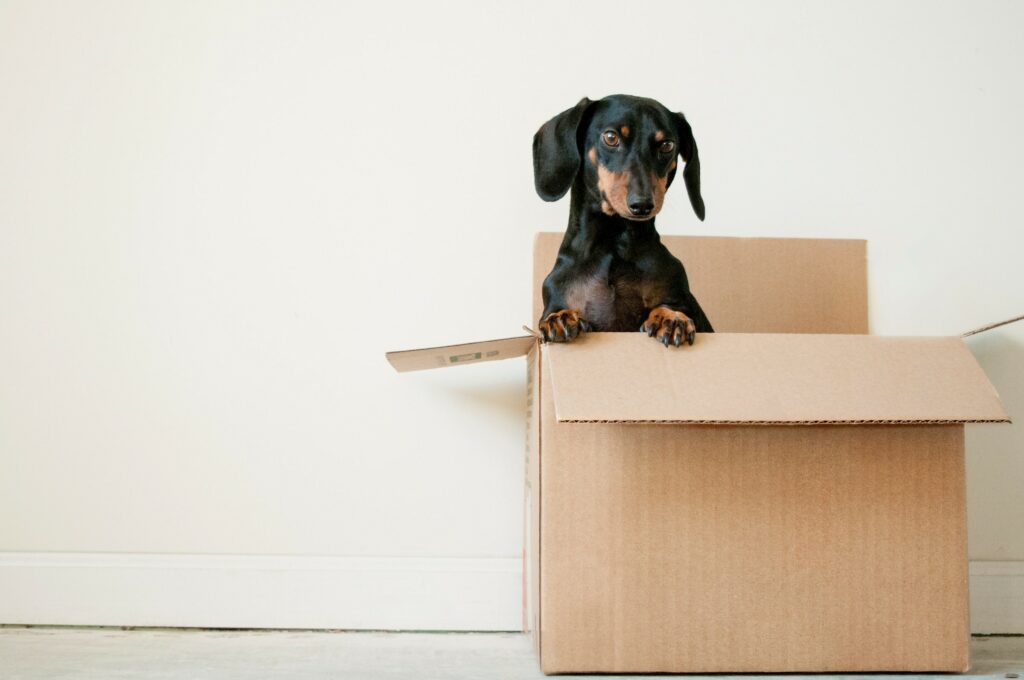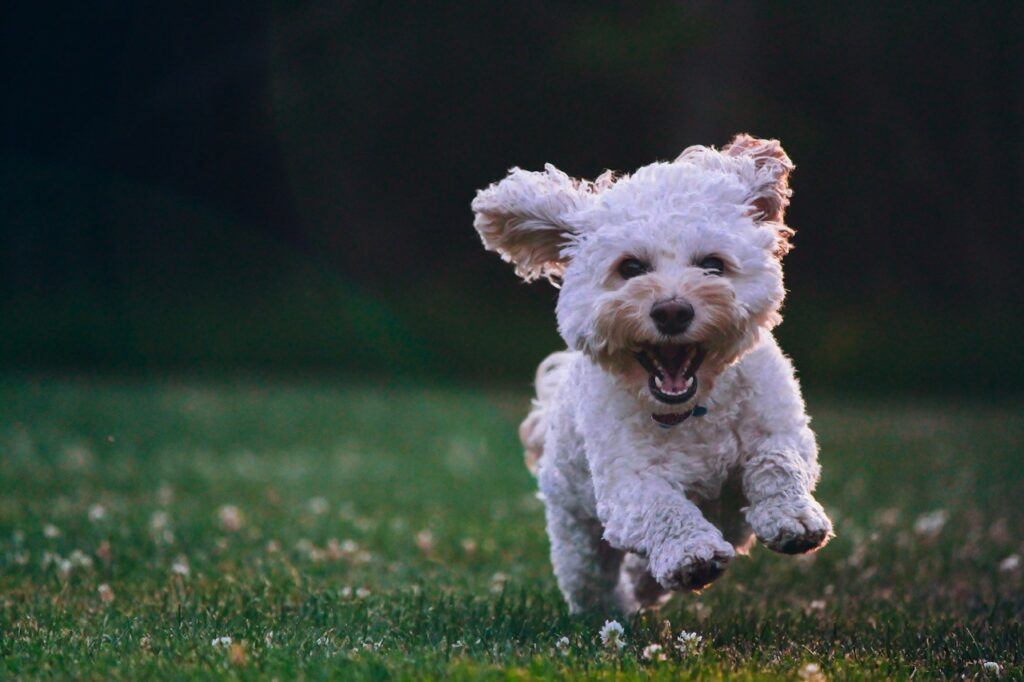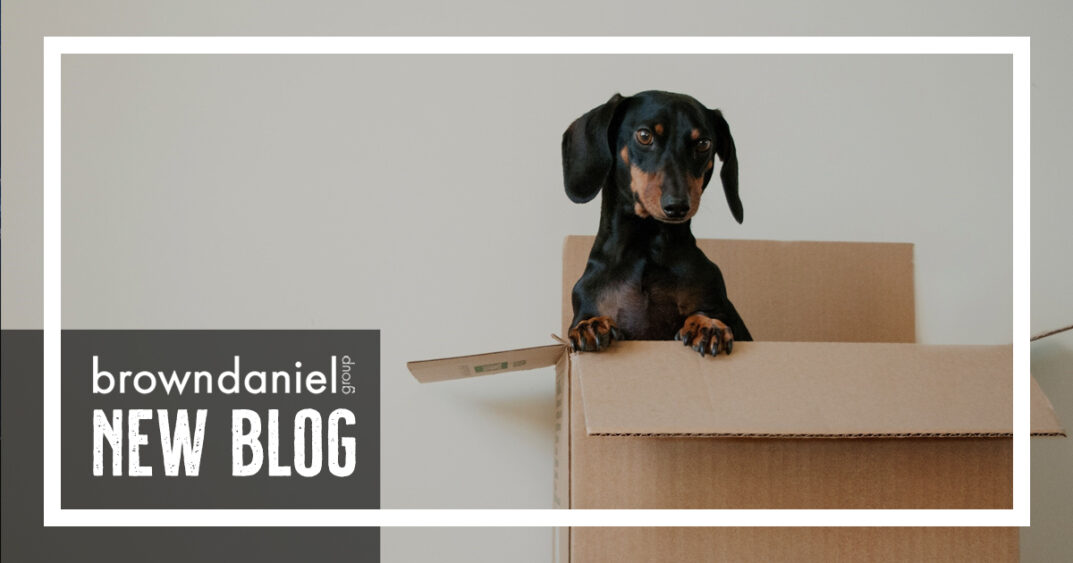
Almost everyone loves the excitement of settling into their new home, but for many of us, the process of getting there is a little bit less enjoyable. Pouring over listings, viewing numerous homes and attending open houses can be a lot of work, even more so if you are selling a home at the same time and have your own staging and viewings to worry about. Decluttering, packing and moving your belongings, even if you hire professionals, can be also be quite the headache. This means that moving can be a stressful time not only for humans, but also for our four legged friends as well. Luckily there are ways that you can ease your dog’s stress when moving into a new home.
Plan Before You Pack
Just like people, dogs an be taken aback by surprising changes to their routine and surroundings. This means that your best bet is to begin the process well before you need to make your move. For example:
- Bring the boxes and other essential moving items like packing tape and bubble wrap into your house well before they are actually needed. Allow your dog to get used to the sight and smell of these supplies so they can get used to them.
- Help your dog to associate these moving supplies with fun things like play and treats, so that your pup develops positive rather than negative feelings towards them.
- While it is important to get your dog used to these items, keep in mind that boxes can easily be damaged by dogs, and some dogs may be tempted to eat bubble wrap and/or tape. Make sure your dog is not left near these items when unattended.
Take Dog Breaks from Packing
Once you have a closing date for both the home you are moving to and the one you are leaving behind, things can start to feel pretty hectic. It is important that you still carve out special time for your dog in the midst of the moving mayhem. Resist the urge to skip your daily walks, as your dog not only needs the exercise, but also needs the stability of the walking routine. You will probably also benefit from this nature break during such a stressful phase of life. Aside from daily walks, take breaks from packing for play time, whether this means a quick hop over to the dog park, or a simple round of fetch in the backyard or indoors. Even short breaks are valuable and will reassure your dog that not everything is changing in their world.
Pack When Your Dog Isn’t Watching

If possible, do most of your packing when your dog isn’t watching. Have another family member provide some distraction outdoors or in another room from where you are working. There are multiple reasons to keep your dog away from the actual packing as much as possible. First, it’s important to know that when dogs see their entire house packed up and in chaos, this can be unsettling for them. The less of the actual packing they have to witness, the better. Now is the perfect time to accept help from friends or family members who have asked what they can do to assist you during your move. No one wants to help move a heavy sofa or washing machine, so it might come as a huge relief that you are taking them up on their offer to help by simply having them watch your dog for a few hours.
Helping Your Dog Adjust After the Move

You may think that once you’ve fully moved in and unpacked, that your dog should feel just as relieved and relaxed was you, However, this transition to a new space may not be as simple and easy for your dog as it is for you. Here are some things you can try to make your dog feel more at ease in the new surroundings.
Stick to Your Old Routines
Your dog is experiencing a lot of changes with your move, which can be inherently stressful. You can counteract this stress by maintaining the same general routine your was used to before the move. If your dog is used to waking up each morning and going outside immediately, then coming in for breakfast, this is the same routine you need to follow in your new space. Dogs that usually go for a walk first thing in the morning will benefit from sticking to this same pattern. Likewise dogs that walk in the evenings, or have a midday fetch session, will need this same frequency of exercise in their new location to minimize stress. Of course, your move may also coincide with a different work schedule or commuting routine, but try to do your best to keep as much of your pets old routine in place as possible. Ideally you could make schedule changes gradually over the course of a couple of weeks. Once your dog has settled in to their new home, additional changes will be much easier to handle.
Don’t Buy Your Dog All New Things

Of course when you move into a new home, its only natural to want to purchase a lot of new items that will match your new home’s decor. When it comes to your pet’s belongings, such as their bed, crate and bowls, try to resist this urge as much as possible. Especially in the beginning, your dog will be greatly comforted by having his or her familiar things. Of course it may not be ideal to bring a worn out and/or fur-covered dog bed into your bedroom alongside fresh new furniture and linens, but your dog needs the familiar scent of their bed to feel comfortable and relaxed, especially when sleeping. The same old water and food bowls that your dog is used to will also be a great source of comfort, and may be the only thing that keeps your dog eating like normal throughout the settling in process. After a few weeks, and your dog is fully settled in, you can gradually begin bringing in replacement belongings for them.
Give Your Dog Lots Of Love and Attention

This may seem like a no brainer – your dog is your best pal, so of course you will be spending a lot of time with him or her, just like always. It sounds easy, but during the chaos of a move, it can be easy to get distracted by all of the work you need to do to set up your new house. From unpacking and organizing to repainting and placing new furniture, you might find it hard to carve out the same time for playing, walking, and just being with your dog. Make sure you are taking breaks to spend time with your dog, because doing so will reassure your pup that even though the location has changed, most things in his or her life will remain the same. Those breaks can also help keep you from becoming too overwhelmed by everything that needs to be done as well. Go for a walk so both you and your dog can get used to all of the sights, sounds (and scents) in your new neighborhood.
Avoid Leaving Your Dog Home Alone At First
You may think you have nothing to worry about because your dog has been comfortable being left home alone for years, but that doesn’t mean they won’t struggle a little bit when left alone in new surroundings. You might be surprised to learn that most dogs are extremely place sensitive and when they are first left alone in a new location, it may conjure up feelings of separation anxiety that they have not experienced before, or at least not since soon after you got them. Try to wait as long as you can before leaving your dog alone at the new house, even if that means you need to take a few extra days off work or miss out on some plans.
Another option is or various members of your household to take turns staying home with the dog for at least the first few days. When you do have to leave your dog, start by leaving for only a few minutes and then returning – do a few trial runs before actually leaving your property. Leave them with something that is safe for them to chew on, as chewing is an important way that dogs relieve stress. You will also want to leave their usual dog bed, crat, or blanket with them for additional comfort.
Be Patient
The most important thing you can do is be patient and give your dog time to adjust at their own pace to the changes involved with moving from one house to another. Some dogs will be perfectly comfortable immediately and will seem like nothing has happened. Others will take a few days to adjust while some will not seem fully settled in until a couple of weeks or months have past by. As long as your pup has you by their side, they will eventually come to love their new home just as much as you do.

